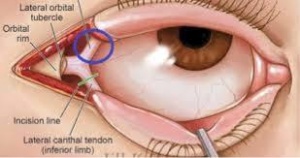Canthotomy: Difference between revisions
ClaireLewis (talk | contribs) No edit summary |
|||
| (2 intermediate revisions by 2 users not shown) | |||
| Line 1: | Line 1: | ||
==Background== | ==Background== | ||
[[File:Canthotomy anatomy.jpeg|thumb|]] | |||
*Acute orbital compartment syndrome (OCS) is a clinical diagnosis | *Acute orbital compartment syndrome (OCS) is a clinical diagnosis | ||
*Vision loss can be permanent after 60-100 min of ischemia<ref name="JEM" /> - do not delay procedure for imaging<ref>Mohammadi F, Rashan A, Psaltis A, et al. Intraocular Pressure Changes in Emergent Surgical Decompression of Orbital Compartment Syndrome. JAMA Otolaryngol Head Neck Surg. 2015 Jun 1;141(6):562-5.</ref> | |||
===Causes<ref name="JEM">Rowh AD, Ufberg JW, Chan TC, et al. Lateral canthotomy and cantholysis: emergency management of orbital compartment syndrome. J Emerg Med. 2015 Mar;48(3):325-30.</ref>=== | ===Causes<ref name="JEM">Rowh AD, Ufberg JW, Chan TC, et al. Lateral canthotomy and cantholysis: emergency management of orbital compartment syndrome. J Emerg Med. 2015 Mar;48(3):325-30.</ref>=== | ||
*Trauma (retrobulbar hematoma) - most common cause | *Trauma ([[retrobulbar hematoma]]) - most common cause | ||
*Spontaneous bleed | *Spontaneous bleed | ||
*Tumor | *Tumor | ||
*Orbital cellulitis/abscess | *[[Orbital cellulitis]]/abscess | ||
*Prolonged hypoxemia | *Prolonged [[hypoxemia]] | ||
==Indications<ref name="CJEM">McInnes G, Howes DW. Lateral canthotomy and cantholysis: a simple, vision-saving procedure. CJEM. 2002 Jan;4(1):49-52.</ref>== | ==Indications<ref name="CJEM">McInnes G, Howes DW. Lateral canthotomy and cantholysis: a simple, vision-saving procedure. CJEM. 2002 Jan;4(1):49-52.</ref>== | ||
| Line 29: | Line 31: | ||
*Betadine prep | *Betadine prep | ||
*Sterile drape or towels | *Sterile drape or towels | ||
*[[Lidocaine]] | *[[Lidocaine]] with epi | ||
**Syringe with 27-30ga needle | **Syringe with 27-30ga needle | ||
*Normal saline for irrigation | *Normal saline for irrigation | ||
| Line 57: | Line 59: | ||
*[[Orbital Hematoma]] | *[[Orbital Hematoma]] | ||
==External Links== | |||
EMRAP procedure video- https://www.youtube.com/watch?v=tgQaKVGynFA | |||
==References== | ==References== | ||
<references/> | <references/> | ||
Revision as of 02:50, 23 August 2019
Background
- Acute orbital compartment syndrome (OCS) is a clinical diagnosis
- Vision loss can be permanent after 60-100 min of ischemia[1] - do not delay procedure for imaging[2]
Causes[1]
- Trauma (retrobulbar hematoma) - most common cause
- Spontaneous bleed
- Tumor
- Orbital cellulitis/abscess
- Prolonged hypoxemia
Indications[3]
- Suspected acute orbital compartment syndrome (OCS), plus one or more of the following:
- Decreased visual acuity
- IOP >40 or marked difference in globe compressibility by palpation
- Proptosis
- Secondary indications (subjective and nonspecific) - if only secondary indications are present, get emergent ophthalmology consult prior to performing canthotomy.
- Afferent pupillary defect
- Cherry red macula
- Ophthalmoplegia
- Nerve head pallor
- Significant eye pain
Contraindications
- Globe Rupture
Equipment
- Betadine prep
- Sterile drape or towels
- Lidocaine with epi
- Syringe with 27-30ga needle
- Normal saline for irrigation
- Straight hemostat or needle driver
- Iris or suture scissors
- Forceps
Procedure[1][3][4]
Consider sedating patient for procedure, if time allows
- Prep and drape the area (Irrigation with normal saline is acceptable prep given emergent nature of procedure)
- Inject lidocaine with epinephrine into the lateral canthus directing the needle tip toward the lateral orbital rim (away from the globe)
- Apply hemostat to the lateral canthus from the angle of the eye to the orbital rim and clamp shut for ~1 min. (provides relative devascularization as well as a landmark for the canthotomy)
- Using scissors, incise the lateral canthus from the angle of the eyelid to the orbital rim (~1cm).
- Retract the inferior lid and bluntly dissect tissue until the canthal tendon is identified.
- Perform inferior cantholysis - cut the inferior crus of the lateral canthus tendon (point scissors infero-posteriorally toward the lateral orbital rim, avoiding the globe)
- Recheck IOP → if still elevated, perform superior cantholysis - cut the superior crus of the canthal tendon (some experts recommend performing both inferior and superior cantholysis at the same time, prior to re-evaluating IOP)
Complications
- Incomplete cantholysis
- Iatrogenic globe or surrounding structure injury (rare)
- Loss of adequate lower lid suspension
- Bleeding
- Infection
See Also
External Links
EMRAP procedure video- https://www.youtube.com/watch?v=tgQaKVGynFA
References
- ↑ 1.0 1.1 1.2 Rowh AD, Ufberg JW, Chan TC, et al. Lateral canthotomy and cantholysis: emergency management of orbital compartment syndrome. J Emerg Med. 2015 Mar;48(3):325-30.
- ↑ Mohammadi F, Rashan A, Psaltis A, et al. Intraocular Pressure Changes in Emergent Surgical Decompression of Orbital Compartment Syndrome. JAMA Otolaryngol Head Neck Surg. 2015 Jun 1;141(6):562-5.
- ↑ 3.0 3.1 McInnes G, Howes DW. Lateral canthotomy and cantholysis: a simple, vision-saving procedure. CJEM. 2002 Jan;4(1):49-52.
- ↑ Ballard SR, Enzenauer RW, O'Donnell T, et al. Emergency lateral canthotomy and cantholysis: a simple procedure to preserve vision from sight threatening orbital hemorrhage. J Spec Oper Med. 2009 Summer;9(3):26-32.



